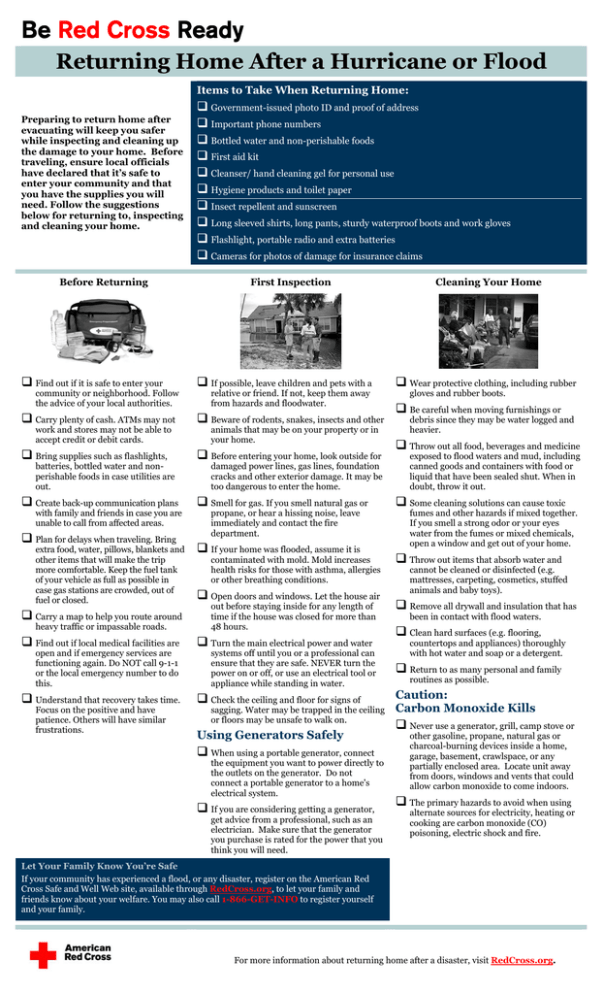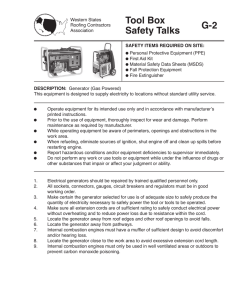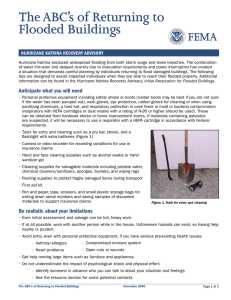Be Ready Red Cross Returning Home After a Hurricane or Flood
advertisement

Be Red Cross Ready Returning Home After a Hurricane or Flood Items to Take When Returning Home: Preparing to return home after evacuating will keep you safer while inspecting and cleaning up the damage to your home. Before traveling, ensure local officials have declared that it’s safe to enter your community and that you have the supplies you will need. Follow the suggestions below for returning to, inspecting and cleaning your home. Before Returning Government-issued photo ID and proof of address Important phone numbers Bottled water and non-perishable foods First aid kit Cleanser/ hand cleaning gel for personal use Hygiene products and toilet paper Insect repellent and sunscreen Long sleeved shirts, long pants, sturdy waterproof boots and work gloves Flashlight, portable radio and extra batteries Cameras for photos of damage for insurance claims First Inspection Find out if it is safe to enter your If possible, leave children and pets with a Carry plenty of cash. ATMs may not Beware of rodents, snakes, insects and other Bring supplies such as flashlights, Before entering your home, look outside for Create back-up communication plans Smell for gas. If you smell natural gas or community or neighborhood. Follow the advice of your local authorities. work and stores may not be able to accept credit or debit cards. batteries, bottled water and nonperishable foods in case utilities are out. with family and friends in case you are unable to call from affected areas. Plan for delays when traveling. Bring extra food, water, pillows, blankets and other items that will make the trip more comfortable. Keep the fuel tank of your vehicle as full as possible in case gas stations are crowded, out of fuel or closed. Carry a map to help you route around heavy traffic or impassable roads. Find out if local medical facilities are open and if emergency services are functioning again. Do NOT call 9-1-1 or the local emergency number to do this. Understand that recovery takes time. Focus on the positive and have patience. Others will have similar frustrations. relative or friend. If not, keep them away from hazards and floodwater. animals that may be on your property or in your home. damaged power lines, gas lines, foundation cracks and other exterior damage. It may be too dangerous to enter the home. propane, or hear a hissing noise, leave immediately and contact the fire department. If your home was flooded, assume it is contaminated with mold. Mold increases health risks for those with asthma, allergies or other breathing conditions. Open doors and windows. Let the house air out before staying inside for any length of time if the house was closed for more than 48 hours. Turn the main electrical power and water systems off until you or a professional can ensure that they are safe. NEVER turn the power on or off, or use an electrical tool or appliance while standing in water. Check the ceiling and floor for signs of sagging. Water may be trapped in the ceiling or floors may be unsafe to walk on. Using Generators Safely When using a portable generator, connect the equipment you want to power directly to the outlets on the generator. Do not connect a portable generator to a home's electrical system. If you are considering getting a generator, get advice from a professional, such as an electrician. Make sure that the generator you purchase is rated for the power that you think you will need. Cleaning Your Home Wear protective clothing, including rubber gloves and rubber boots. Be careful when moving furnishings or debris since they may be water logged and heavier. Throw out all food, beverages and medicine exposed to flood waters and mud, including canned goods and containers with food or liquid that have been sealed shut. When in doubt, throw it out. Some cleaning solutions can cause toxic fumes and other hazards if mixed together. If you smell a strong odor or your eyes water from the fumes or mixed chemicals, open a window and get out of your home. Throw out items that absorb water and cannot be cleaned or disinfected (e.g. mattresses, carpeting, cosmetics, stuffed animals and baby toys). Remove all drywall and insulation that has been in contact with flood waters. Clean hard surfaces (e.g. flooring, countertops and appliances) thoroughly with hot water and soap or a detergent. Return to as many personal and family routines as possible. Caution: Carbon Monoxide Kills Never use a generator, grill, camp stove or other gasoline, propane, natural gas or charcoal-burning devices inside a home, garage, basement, crawlspace, or any partially enclosed area. Locate unit away from doors, windows and vents that could allow carbon monoxide to come indoors. The primary hazards to avoid when using alternate sources for electricity, heating or cooking are carbon monoxide (CO) poisoning, electric shock and fire. Let Your Family Know You’re Safe If your community has experienced a flood, or any disaster, register on the American Red Cross Safe and Well Web site, available through RedCross.org, to let your family and friends know about your welfare. You may also call 1-866-GET-INFO to register yourself and your family. For more information about returning home after a disaster, visit RedCross.org.






